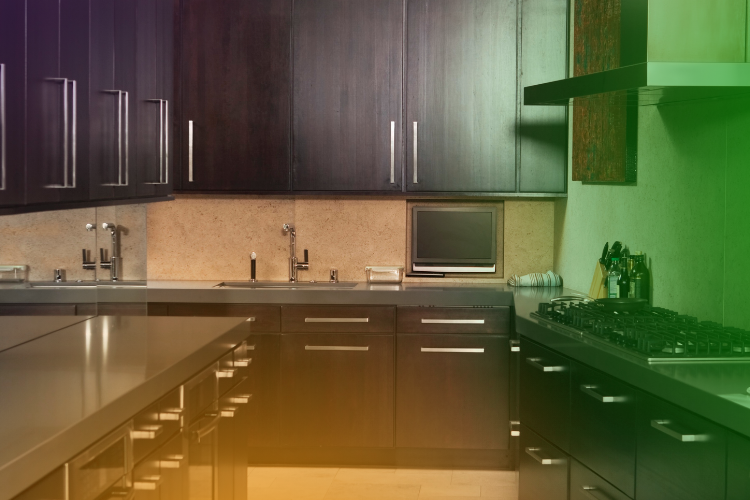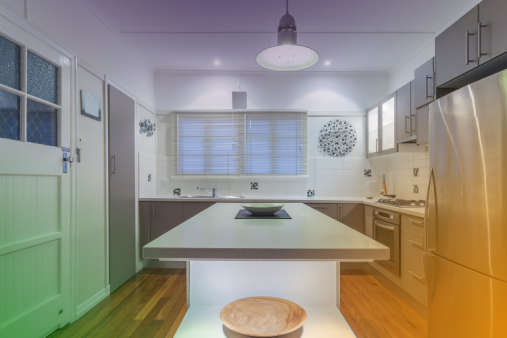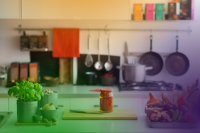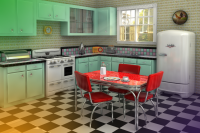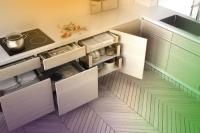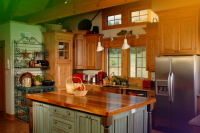Galley Kitchen Ideas
Galley kitchens are commonly found in older properties, stemming from a time where the kitchen was a functional space used for cooking only, rather than the communal living areas we use them as now. The name “galley kitchen” comes from ships, where the kitchen on board is known as a galley. Galley kitchens are long and narrow typically with cabinets and appliances down along each wall, and a space in the middle. As galley kitchens are smaller than other styles of kitchens the good news is that giving one a makeover is likely to be considerably more cost-effective than updating a larger room. In a smaller room though it’s even more important to be clever with your design, not just to squeeze everything into the space, but to stop a narrow kitchen feeling even more closed in and tiny.
Where to Put Appliances in a Galley Kitchen
Most people who are designing their own kitchen are aware of the “triangle” principle which is about putting the cooker, fridge and sink at the three points of a triangle to make using the kitchen easier. This rule isn’t absolutely set in stone, but does make using your space more efficient and its best to try to stick to it where possible. If you choose not to use the triangle layout and locate your appliances in a different way, then the risk is you spend time walking from one spot to the other to perform the necessary kitchen tasks. Think also about whether your galley kitchen is open at both ends, and whether other people might be needed to walk through as you’re working. If this is the case, it’s often best to have the sink, cooker and workspace along one side of the room so you are not constantly colliding with pets and children walking through the room. If your kitchen ends in a wall, or the back door, this might not be so much of a consideration.
Location of Shelves and Cabinets in a Narrow Kitchen
The temptation in a smaller galley kitchen is to put as many cupboards and shelves into the space as possible to maximise storage and keep countertops uncluttered. But cramming in too many cupboards can make the entire space seem cramped and crowded, and even smaller. However, there’s a delicate balance to be struck to ensure that you have enough space to store everything you need to. If you are struggling to work out the best placement of your kitchen units and shelves in a smaller space, then using a kitchen design service can be a very good idea. An expert will have dealt with many rooms likes yours before. They will know what works, and more importantly, what doesn’t work.
A classic configuration for a galley kitchen is to have a run of low cabinets along each side, in a symmetrical design. Keeping the upper walls free of cabinets can help the space feel bigger. A good option if you just don’t have enough space to keep everything in cupboards at a lower level is to add in some open shelving above, which you can use to display pretty crockery or kitchen appliances which are regularly in use. Experiment with different layouts and configurations of cupboards to get the ideal combination for you. Taking a trip to a kitchen showroom, or looking at lots of pictures online can show you what other people have achieved in spaces similar to the one you are working with.
Getting the Lighting Right in a Galley Kitchen
Lighting is often left as an afterthought but when you are planning a galley kitchen it should be one of the first things you consider. Getting your lighting right can transform a narrow, dingy space into one which feels airy and comfortable. Natural light should be maximised where at all possible, so this means trying not to block any light coming into the room from windows or skylights with shelving or cupboards. Designers talk about lighting “layers” for galley kitchens and by this they just mean having different sources of light rather than only one main pendant light. Think about installing lights under kitchen cabinets, having lamps on shelves or even a string of fairy lights along the edge of your shelving. This allows you to adjust the level of lighting depending on what you are doing in the kitchen. You should also incorporate what is known as task lighting – a spot of light perhaps over the hob or worksurface to light up the space you are using for your main work tasks. Pendant lighting can also be used to draw attention to a particular feature of your kitchen.
Choosing Colours for a Galley Kitchen
Colour is a matter of personal preference, and the most important factor of all is that you choose something which you personally like. If you’re trying to make your galley kitchen seem bigger, the classic design rule is to stick to light neutrals. Look at shades of white, cream or stone for your flooring and cabinets which will lighten up the space and make it feel bigger. Putting in white worktops and tiles might be a bit too much in addition to everything else being white, so look perhaps at wooden or quartz worksurfaces for a natural finish.
If you’re more drawn to the current fashion for darker kitchens in shades of deep green or navy blue, you can still use these in a galley kitchen. Opting for a gloss rather than a matt finish will bounce the light around the room, and if you choose darker cabinets, mix those with a much lighter shade for the worksurfaces, flooring and perhaps tiles too. Feature walls can also be used to add colour into a kitchen, either by painting the walls, or choosing some vibrant tiles to make a backsplash over the sink or cooker. A less permanent option is to keep the walls and tiles neutral, but to source some brightly coloured artwork which you can hang in the kitchen.
